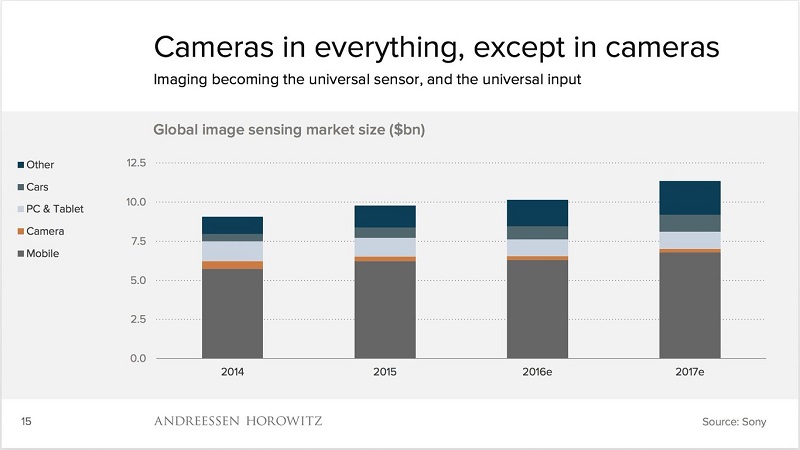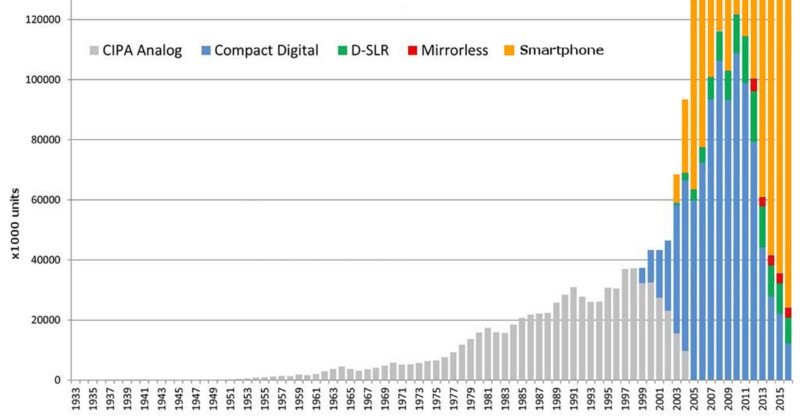To the compact cameras is killing the mobile phone, I do not say, nor do I want to compare the capabilities and utility of different gadgets: it is clearly seen in a graph that has prepared the photographer Sven Skafisk. It drinks data from the CIPA – along with Gartner – from 1933 to last year.
What is the CIPA? The international association that has the industry to promote the development and production of image systems, monitoring the good competition. Come on, the data is what they are, since almost all cameras and gadgets related to sensors leave their members, by the way, are mostly Japanese.

It is very interesting, we have a period so broad that we can see the life of consumer photography, where clearly the analogue cameras reigned longer, but did not sell more units annually. The explosion of digital technology in the late nineties leaves us a new panorama in which compact, DSLR and smartphones.
Shortly afterwards came the “no mirror”, at a time when cameras could no longer curb the fight against camera phones. I repeat, with this article I do not try to defend the quality of any device over another, only offer evidence of two things: the obvious growth of sales of phones, and the fall of the cameras.
The loss of interest in the cameras cannot be said to be the same at all levels. With the advent of digital technology, the compact ones grew very important, taking their peak in 2011. From there they began to drop sales until they reach a point where they resemble those that may have DSLR equipment, which are quite expensive gadget.
The difference between phone sales and the rest of the cameras is so great that the graphics is quite difficult to represent in the format of our website. That is why I have left it to the end, there will not disturb the rest of the reading. Above you have a graphic cut, at the end of the article, complete.

Mirrors have not saved the market
As for the DSLR and mirrorless cameras, the thing seems less painful, although it is stagnant : the “no mirror” moves in an approximate production of 3 million units for each of the last four years, while the big ones have Was losing bellows, going from 13 to 8.2 million units in the same period.
You may also like to read another article on YellowTube: Machine Learning and Deep Learning: Understanding the Keys to the Present and Future of Artificial Intelligence
Of the mirrorless were expected much more, came with the promise that would end with the DSLR and thanks to its more compact size, would attract new audiences. It is a reality that there are great products in this segment, but they have failed to save the market.
Photography is more popular than ever, but cameras as such are increasingly sold less: 98.4% of sales in 2016 correspond to smartpthones, 0.8% are compact, 0.5% DSLR cameras, and the mirrorless 0.2%. With all this data on hand you cannot be surprised by the state of companies like Nikon, and the decision to move from compact.
Another of the striking points that are drawn from these studies is that the “big” cameras only interest the elderly people – between 40 and 60 – who are the ones who have the money and the history of having been working with cameras for a long time. Young people have plenty of possibilities with the smartphone, which they always carry on.

Where is the second hand?
The data that the CIPA shares deal with camera devices that are sold first hand, but nowhere is information about the second hand. We have to be aware that the second-hand market of mid-high-end cameras is especially powerful : lenses and cameras continue to have more life in the hands of new users.
We have another factor to introduce, and it is something that can sound to the excuse that we put to the tablets and computers when they are sold less: what need is there to change? Soon enough, anyone who buys a camera – at different levels – can be very satisfied with the quality they offer.
The future speaks of missing compact cameras, more and more smartphones that make better photos. Obviously, there will always be people interested in better cameras – prosumers or professionals – with special capabilities that give you larger sensors, special specs, lenses and other accessories.
Whether it’s cameras or mobile, what seems enchanted with the situation is Sony, which creates sensors of all types and forms, we can say that it leads the technology and makes the rest dependent.
